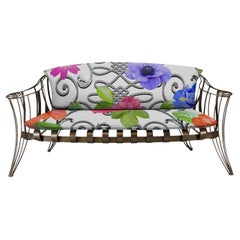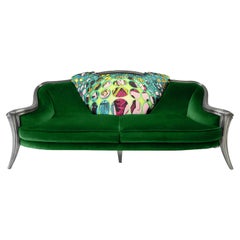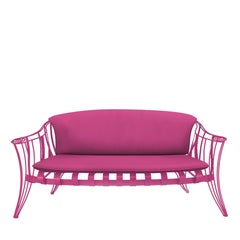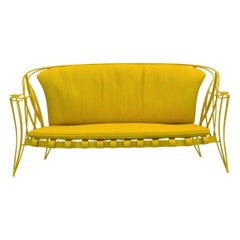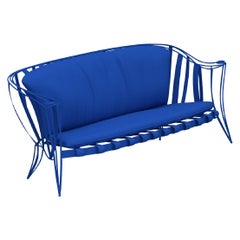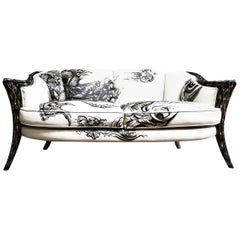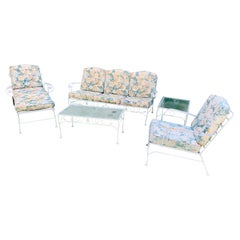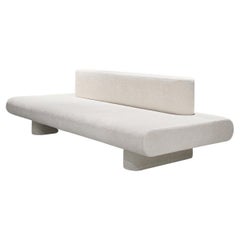Sergio Villa Sofas
9
to
9
3
9
Height
to
Width
to
Depth
to
9
9
9
9
9
9
9
9
9
9
9
9
5
5
4
3
3
9
9
53
461
293
172
167
Creator: Sergio Villa
Opus White Flower Garden sofa by Carlo Rampazzi
By Sergio Villa
Located in Milan, IT
Introducing the opulent Opus Garden White Flower sofa, a design piece by Carlo Rampazzi. This extraordinary piece boasts an intricately hand-bended iron fr...
Category
2010s Italian Sergio Villa Sofas
Materials
Iron
Opus Stupendo Metallica Green Sofa by Carlo Rampazzi
By Sergio Villa
Located in Milan, IT
A triumph of sinuous curves and eclectic, colorful details lends this sofa its iconic look. The finely-sculpted wooden shell is lacquered with a special varnish containing 95% of met...
Category
2010s Italian Sergio Villa Sofas
Materials
Wood
Opus Fuchsia Garden Sofa by Carlo Rampazzi
By Sergio Villa
Located in Milan, IT
Romantic and airy, this garden sofa by Carlo Rampazzi will add a glamorous accent to any outdoor space. Its enveloping iron frame is bent by hand and enriched with a special rust-res...
Category
2010s Italian Sergio Villa Sofas
Materials
Iron
Opus Garden Yellow Sofa by Carlo Rampazzi
By Sergio Villa
Located in Milan, IT
A fine example of skilled craftsmanship and innovative design, this outdoor sofa boasts a highly graphic and sculptural design that will stand out in a modern garden, patio, and pool area. The frame consists of iron rods bent by hand to form a sinuous silhouette recalling Classic tub sofas...
Category
2010s Italian Sergio Villa Sofas
Materials
Iron
Opus Garden Blue Sofa by Carlo Rampazzi
By Sergio Villa
Located in Milan, IT
Part of the Opus Garden Collection, this versatile sofa merges an Industrial-inspired design with a Classic Silhouette in an iron frame with rust-proof finish perfectly suited for ou...
Category
2010s Italian Sergio Villa Sofas
Materials
Iron
Opus Futura 2-Seat Tattoo Sofa by Carlo Rampazzi
By Sergio Villa
Located in Milan, IT
A stunning addition to a modern or eclectic home, this one-of-a-kind two-seat sofa, part of the Opus Futura collection, will make a statement in living room, bedroom or study, infusi...
Category
2010s Italian Sergio Villa Sofas
Materials
Leather, Wood
Opus Futura 2-Seat Sirena Sofa by Carlo Rampazzi
By Sergio Villa
Located in Milan, IT
This stunning sofa is part of the Opus Futura collection, a series of eclectic seating options that will make an elegant statement in a modern or cont...
Category
2010s Italian Sergio Villa Sofas
Materials
Leather, Wood
Opus Garden Sofa by Carlo Rampazzi
By Sergio Villa
Located in Milan, IT
This elegant sofa is part of the Opus Garden collection, specifically designed to be used outdoors, thanks to the protective rust-resistant treatment on the iron structure of its pie...
Category
2010s Italian Sergio Villa Sofas
Materials
Iron
Opus Futura 2-Seat Sofa by Carlo Rampazzi
By Sergio Villa
Located in Milan, IT
Part of the Opus Futura collection, this two-seat sofa is a pop of vivid color and a superb addition to an eclectic or contemporary home. Its structure in wood has a vitrified stucco...
Category
2010s Italian Sergio Villa Sofas
Materials
Leather, Wood
Related Items
Vintage Wrought Iron Sofa Set Refinished by TVPB
By John Salterini, Russell Woodard
Located in Cumberland, RI
Vintage Wrought iron sofa set Refinished by TVPB
This set will be completely refinished being sandblasted and powder coated in choice of col...
Category
Mid-20th Century Mid-Century Modern Sergio Villa Sofas
Materials
Metal, Iron, Wrought Iron
Modular Lounge Sofa Seating Flowers by Olga Engel
By Olga Engel
Located in Amsterdam, NL
Olga Engel's new Flowers modular collection comprises of a sofa and modular chairs. Chairs can be connected versus each other in a multiple way. Flowers is an allusion to simple whit...
Category
2010s Latvian Sergio Villa Sofas
Materials
Fabric, Plywood
Scandinavian Midcentury Rosewood Sofa "Monte Carlo", 1965
By Ingvar Stockum, Futura Möbler
Located in Karlstad, SE
Top-quality lounge sofa designed by Ingvar Stockum for Futura Möbler in 1965.
The "Monte Carlo" series was only in production for two years because production costs were too high. ...
Category
20th Century Swedish Scandinavian Modern Sergio Villa Sofas
Materials
Fabric, Rosewood
Metal Mid Century Garden Poolside Sofa bench by Homecrest
By Homecrest
Located in New York, NY
Probably the most sought after form made by Homecrest, this settee if from the Chiquita series circa 1960's. This example is in very good, original estate condition, showing only the...
Category
Mid-20th Century American Mid-Century Modern Sergio Villa Sofas
Materials
Steel
Cornaro 300 Sofa by Carlo Scarpa in Green Chenille Velvet
By Carlo Scarpa
Located in Ozzano Dell'emilia, IT
Cornaro 300 sofa designed by Carlo Scarpa. Solid hardwood structure (iroko). Polyurethane padding. Upholstery in original chenille velvet. The one-uni...
Category
1970s Italian Mid-Century Modern Vintage Sergio Villa Sofas
Materials
Velvet, Wood
Carlo Scarpa Iroko Wood and Green Velvet Cornaro Sofa for Studio Simon, 1974
By Carlo Scarpa, Studio Simon
Located in Vicenza, IT
Cornaro two-seater sofa, designed by Carlo Scarpa and manufactured by Studio Simon in 1974.
Made of Iroko wood, foam, and azure chenille velvet.
Excellent vintage condition.
Born in Venice on June 2nd, 1906, Carlo Scarpa began working very early. Only a year after he had first qualified as an architect in 1926, he began working for the Murano glassmakers Cappellin & Co. in a consultative capacity; from 1927, he began to experiment with the Murano glass, and this research not only gave him excellent results here but would also inform his progress for many years to come. Between 1935 and 1937, as he entered his thirties, Carlo Scarpa accepted his first important commission, the renovation of Venice’s Cà Foscari. He adapted the spaces of this stately University building which stands on the banks of the Grand Canal, creating rooms for the Dean’s offices and a new hall for academic ceremonies; Mario Sironi and Mario De Luigi were charged with doing the restoration work on the frescos. After 1945, Carlo Scarpa was constantly busy with new commissions, including various furnishings and designs for the renovation of Venice’s Hotel Bauer and designing a tall building in Padua and a residential area in Feltre, all worth mentioning. One of his key works, despite its relatively modest diminished proportions, was the first of many works which were to follow in the nineteen fifties: the [bookshop known as the] Padiglione del Libro, which stands in Venice’s Giardini di Castello and shows clearly Scarpa’s passion for the works of Frank Lloyd Wright. In the years which were to follow, after he had met the American architect, Scarpa repeated similar experiments on other occasions, as can be seen, in particular, in the sketches he drew up in 1953 for villa Zoppas in Conegliano, which show some of his most promising work. However, this work unfortunately never came to fruition. Carlo Scarpa later created three museum layouts to prove pivotal in how twentieth-century museums were set up from then on. Between 1955 and 1957, he completed extension work on Treviso’s Gipsoteca Canoviana [the museum that houses Canova’s sculptures] in Possagno, taking a similar experimental approach to the one he used for the Venezuelan Pavilion at [Venice’s] Giardini di Castello which he was building at the same time (1954-56). In Possagno Carlo Scarpa was to create one of his most incredible ever works, which inevitably bears comparison with two other museum layouts that he was working on over the same period, those of the Galleria Nazionale di Sicilia, housed in the Palazzo Abatellis in Palermo (1953-55) and at the Castelvecchio in Verona (1957- 1974), all of which were highly acclaimed, adding to his growing fame. Two other buildings, which are beautifully arranged in spatial terms, can be added to this long list of key works that were started and, in some cases, even completed during the nineteen fifties. After winning the Olivetti Award for architecture in 1956, Scarpa began work in Venice’s Piazza San Marco on an area destined to house products made by the Industrial manufacturers Ivrea. Over the same period (1959-1963), he also worked on renovating and restoring the gardens and ground floor of the Fondazione Querini Stampalia in Venice, which many consider one of his greatest works. While he worked on-site at the Fondazione Querini Stampalia, Carlo Scarpa also began building a villa in Udine for the Veritti family. To shed some light on how much his work evolved over the years, it may be useful to compare this work with that of his very last building, villa Ottolenghi Bardolino, which was near completion at the time of his sudden death in 1978. Upon completion of villa Veritti over the next ten years, without ever letting up on his work on renovation and layouts, Scarpa accepted some highly challenging commissions which were to make the most of his formal skills, working on the Carlo Felice Theatre in Genoa as well as another theatre in Vicenza.
Towards the end of this decade, in 1969, Rina Brion commissioned Carlo Scarpa to build the Brion Mausoleum in San Vito d’Altivole (Treviso), a piece he continued to work on right up until the moment of his death. Nevertheless, even though he was totally absorbed by work on this mausoleum, plenty of other episodes can offer some insight into the final years of his career. As work on the San Vito d’Altivole Mausoleum began to lessen in 1973, Carlo Scarpa started building the new headquarters for the Banca Popolare di Verona. He drew up plans that were surprisingly different from the work he carried out simultaneously on the villa Ottolenghi. However, the plans Carlo Scarpa drew up, at different times, for a monument in Brescia’s Piazza della Loggia commemorating victims of the terrorist attack on May 28th, 1974, make a sharp contrast to the work he carried out in Verona, almost as if there is a certain hesitation after so many mannered excesses. The same Pietas that informs his designs for the Piazza Della Loggia can also be seen in the presence of the water that flows through the Brion Mausoleum, almost as if to give a concrete manifestation of pity in this twentieth-century work of art. Carlo Scarpa has put together a highly sophisticated collection of structures occupying the mausoleum’s L-shaped space stretching across both sides of the old San Vito d’Altivole cemetery. A myriad of different forms and an equally large number of different pieces, all of which are separate and yet inextricably linked to form a chain that seems to offer no promise of continuity, arising out of these are those whose only justification for being there is to bear the warning “si vis vitam, para mortem,” [if you wish to experience life prepare for death] as if to tell a tale that suggests the circle of time, joining together the commemoration of the dead with a celebration of life. At the entrance of the Brion Mausoleum stand the “propylaea,” followed by a cloister that ends by a small chapel, with an arcosolium bearing the family sarcophagi, the central pavilion, held in place on broken cast iron supports, stands over a mirror-shaped stretch of water and occupies one end of the family’s burial space. The musical sound of the walkways, teamed with the luminosity of these harmoniously blended spaces, shows how, in keeping with his strong sense of vision, Carlo Scarpa could make the most of all his many skills to come up with this truly magnificent space. As well as an outstanding commitment to architectural work, with the many projects we have already seen punctuating his career, Carlo Scarpa also made many equally important forays into the world of applied arts. Between 1926 and 1931, he worked for the Murano glassmakers Cappellin, later taking what he had learned with him when he went to work for the glassmakers Venini from 1933 until the 1950s. The story of how he came to work on furniture design is different, however, and began with the furniture he designed to replace lost furnishings during his renovation of Cà Foscari. The later mass-produced furniture started differently, given that many pieces were originally one-off designs “made to measure.” Industrial manufacturing using these designs as prototypes came into being thanks to the continuity afforded him by Dino Gavina, who, as well as this, also invited Carlo Scarpa to become president of the company Gavina SpA, later to become SIMON, a company Gavina founded eight years on, in partnership with Maria Simoncini (whose own name accounts for the choice of company name). Carlo Scarpa and Gavina forged a strong bond in 1968 as they began to put various models of his into production for Simon, such as the “Doge” table, which also formed the basis for the “Sarpi” and “Florian” tables. In the early seventies, other tables that followed included “Valmarana,” “Quatour,” and “Orseolo.” While in 1974, they added a couch and armchair, “Cornaro,” to the collection and the “Toledo” bed...
Category
1970s Italian Mid-Century Modern Vintage Sergio Villa Sofas
Materials
Velvet, Foam, Chenille, Wood
H 25.6 in W 86.62 in D 34.26 in
Modern Twins Outdoors Sofa, Sunbrella Fabric, Handmade in Portugal by Greenapple
By Greenapple, Rute Martins
Located in Lisboa, PT
Twins Sofa Outdoors, Contemporary Collection, Handcrafted in Portugal - Europe by Greenapple.
Designed by Rute Martins for the Contemporary Collection, th...
Category
21st Century and Contemporary Portuguese Modern Sergio Villa Sofas
Materials
Leather, Fabric, Wood
H 29.53 in W 133.86 in D 24.41 in
Ficks Reed Rattan Sofa
By Ficks Reed
Located in Stamford, CT
A 1960s natural finish three seat rattan Ficks Reed sofa from a beautiful North Shore of Long Island estate. In excellent original condition. We have two matching Ficks Reed swivel rattan saucer...
Category
1960s American Mid-Century Modern Vintage Sergio Villa Sofas
Materials
Fabric, Rattan
Sofa by Gio Ponti for Home and Garden
By Gio Ponti, Casa e Giardino
Located in Lucca, IT
Sofa by Gio Ponti for Home and Garden 1950 .This sofa is a two-seater , it is a sofa with soft and enveloping lines , with its rounded line is a design icon of the 1950s .It sets w...
Category
1950s Italian Mid-Century Modern Vintage Sergio Villa Sofas
Materials
Velvet, Wood
Nube Italia Tender Sofa in Orange Upholstery by Carlo Colombo
By Carlo Colombo, Nube Italia
Located in New York, NY
Metal frame with braided elastic belts and internal multi-layered wood backrest. Seat cushions in feather and shape retaining polyurethane foam, covered in Nortek cotton. Backrest cu...
Category
21st Century and Contemporary Italian Modern Sergio Villa Sofas
Materials
Fabric, Wood
Modern Outdoor Sofa Folding Daybed Upholstered in Outdoor Blue Striped Fabric
By Hommes Studio
Located in Porto, PT
Foil Daybed is a luxury daybed. Are you looking for a modern sofa whose design won’t perish over time? You found it. Foil’s ergonomic structure and delic...
Category
21st Century and Contemporary Portuguese Mid-Century Modern Sergio Villa Sofas
Materials
Fabric, Bouclé
H 34.65 in W 82.68 in D 44.1 in
Russell Woodard Style Vintage Metal Garden Sofa and Chairs Seating Ensemble
By Russell Woodard
Located in Sheffield, MA
Stylish and inviting, this vintage wrought iron sofa and two matching garden lounge chairs are in the manner of maker, Russell Woodard and De...
Category
Mid-20th Century American Mid-Century Modern Sergio Villa Sofas
Materials
Wrought Iron
H 32.5 in W 62 in D 26 in
Sergio Villa sofas for sale on 1stDibs.
Sergio Villa sofas are available for sale on 1stDibs. These distinctive items are frequently made of wood and are designed with extraordinary care. There are many options to choose from in our collection of Sergio Villa sofas, although brown editions of this piece are particularly popular. If you’re looking for additional options, many customers also consider sofas by Dom Edizioni, Michele de Lucchi, and Carlo Colombo. Prices for Sergio Villa sofas can differ depending upon size, time period and other attributes — on 1stDibs, these items begin at $7,310 and can go as high as $24,720, while a piece like these, on average, fetch $9,000.
